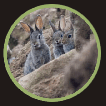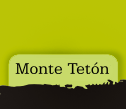

|
 |
 |
WILD BOAR - XABARIN
Sus scrofa
ORDER: Artiodactyla.
FAMILY: Suidae. |
 |
 |
DESCRIPTION: The body of the wild boar is compact; the head is large, the legs relatively short. The fur consists of stiff bristles and usually finer fur. The colour usually varies from dark grey to black or brown, but there are great regional differences in colour; during winter the fur is much denser. Adult boars average 120-180 cm in length and have a shoulder height of 90 cm. As a whole, their average weight is 60-80 kilograms (132-154 pounds), though boars show a great deal of weight variation within their geographical ranges.
The continuously growing tusks (the canine teeth) serve as weapons and tools. The lower tusks of an adult male measure about 20 cm (7.9 in) (from which seldom more than 10 cm (3.9 in) protrude out of the mouth), in exceptional cases even 30 cm (12 in). The upper tusks are bent upwards in males, and are regularly ground against the lower ones to produce sharp edges. In females they are smaller, and the upper tusks are only slightly bent upwards in older individuals.
BEHAVIOUR: Wild boars live in groups called sounders. Sounders typically contain around 20 animals, but groups of over 50 have been seen. In a typical sounder there are two or three sows and their offspring; adult males are not part of the sounder outside of a breeding cycle, two to three per year, and are usually found alone. Birth, called farrowing, usually occurs in a secluded area away from the sounder; a litter will typically contain 8-12 piglets. The animals are usually nocturnal, foraging from dusk until dawn but with resting periods during both night and day. They eat almost anything they come across, including grass, nuts, berries, carrion, roots, tubers, refuse, insects, small reptiles, etc.
|
 |

|
 |
 |
IBERIAN HARE -LEBRE COMÚN
Lepus granatensis
ORDER: Lagomorpha.
FAMILY: Leporidae. |
 |
 |
DESCRIPTION: It is related to the similarly appearing rabbit, which is in the same family but a different genus. It breeds on the ground rather than in a burrow and relies on speed to escape.It is larger, longer-eared, and longer-legged than a rabbit. It has a body size of 50-70 cm and a tail length of 7-11 cm. The weight for a full-grown adult ranges from 2.5 to 6.5 kg. It can run at speeds of up to 70 km/h (45 mi/h). It is strictly herbivorous. It eats grasses and herbs during the summer months but changes to feeding on twigs, bark, and the buds of young trees in winter,
BEHAVIOUR: Normally shy animals, hares change their behaviour in spring, when they can be seen in broad daylight chasing one another around meadows; this appears to be competition between males to attain dominance (and hence more access to breeding females).
During this spring frenzy, hares can be seen "boxing". This is where hares strike one another with their paws. For a long time it had been thought that this was more inter-male competition, but closer observation has revealed that it is usually a female hitting a male, either to show that she is not yet quite ready to mate or as a test of his determination and fitness.
|
 |
|

|
|
 |
 |
ROE DEER - CORZO
Capreolus capreolus
ORDER: Artiodactyla.
FAMILY: Cervidae.
|
 |
 |
DESCRIPTION: The Roe Deer is a relatively small deer, with a body length of 95-135 cm (3.1 - 4.4 ft), a shoulder height of 65-75 cm (2.1 - 2.5 ft), and a weight of 15-30 kg (33-66 lb). It has rather short, erect antlers and a reddish body with a grey face. Its hide is golden red in summer, darkening to brown or even black in winter, with lighter undersides and a white rump patch; the tail is very short (2-3 cm, or 0.8 - 1.2 in), and barely visible. Only the males have antlers, which are lost during winter, but which re-grow in time for the mating season.
BEHAVIOUR: The Roe Deer is primarily crepuscular, or primarily active during the twilight, very quick and graceful, living in woods although it may venture to grasslands and sparse forests. It feeds mainly on grass, leaves, berries and young shoots.The Roe Deer attains a maximum life span (in the wild) of ten years. When alarmed, it will bark a sound much like a dog and flash out its white rump patch. Rump patches differ between the sexes, with the white rump patches heart-shaped on females and kidney-shaped on males. Males may also bark, make a low grunting noise or make a high pitched wolf-like whine when attracting mates during the breeding season, often luring multiple does into their territory. The Roe Deer spends most of its life alone, preferring to live solitary except when mating during the breeding season.
|
 |

|
 |
 |
EUROPEAN RABBIT - COELLO COMÚN
Oryctolagus cuniculus
ORDER: Lagomorpha.
FAMILY: Leporidae.
|
 |
 |
DESCRIPTION: The European Rabbit is a small, grey-brown mammal ranging from 34-45 cm (13-18 inches) in length, and is approximately 1.3-2.2 kg (3-5 lb) in weight. As a lagomorph, it has four sharp incisors (two on top, two on bottom) that grow continuously throughout its life, and two peg teeth on the top behind the incisors, dissimilar to those of rodents (which have only 2 each, top and bottom). Rabbits have long ears, large hind legs, and short, fluffy tails. Rabbits move by hopping, using their long and powerful hind legs. To facilitate quick movement, a rabbit's hind feet have a thick padding of fur to dampen the shock of rapid hopping. Their toes are long, and are webbed to keep from spreading apart as the animal jumps.
BEHAVIOUR: Rabbits are gregarious, social animals, living in medium-sized colonies known as warrens. Rabbits are largely crepuscular, being most active around dawn and dusk, although they are not infrequently seen active during the day. Rabbits are essentially mixed-feeders, both grazing and browsing, but grass is their primary food source.
The gestation cycle for a rabbit averages 31 days, although it can vary anywhere between 29 and 35 days. Litter sizes generally range between two to twelve rabbits. The young are born in a nesting burrow dug by the female, which she returns to once a day for four weeks in order for them to suckle.
|
 |
|

|
|
 |
 |
RED FOX - RAPOSO COMÚN
Vulpes vulpes
ORDER: Carnivora.
FAMILY: Canidae.
|
 |
 |
DESCRIPTION: The largest species within the genus Vulpes, the Red Fox may reach an adult weight of 3–11 kg (6.5–24 lb),Head and body length is 18 to 33.75 in (46 to 86 cm), with a tail of 12 to 21.75 in (30.5 to 55.5 cm).The Red Fox is most commonly a rusty red, with white underbelly, black ear tips and legs, and a bushy tail usually with a distinctive white tip. The "red" tone can vary from dark chestnut to golden, and in fact can be "agouti", with bands of red, brown, black and white on each individual hair. Its long bushy tail with distinctive white tip provides balance for large jumps and complex movement. Its strong legs allow it to reach speeds of approximately 48 km/h (30 miles per hour), a great benefit to catching prey or evading predators.
BEHAVIOUR: The Red Fox is primarily crepuscular with a tendency to becoming nocturnal in areas of great human interference (and artificial lighting); that is to say, it is most active at night and at twilight. It is generally a solitary hunter. If a fox catches more food than it can eat, it will bury the extra food (cache) to store it for later.
Red Foxes are largely carnivorous. The majority of their diet consists of invertebrates, such as insects, mollusks, earthworms and crayfish. They do also eat some plant material, especially blackberries, apples, plums and other fruit. Common vertebrate prey includes rodents (such as mice and voles), rabbits, birds, eggs, amphibians, small reptiles, fish, and they will scavenge carrion and other edible material they find.
The Red Fox primarily forms monogamous pairs each winter, which cooperate to raise a litter of 4–6 kits (also called pups) each year; but in various locales and for various incompletely explored reasons they may also practice polygamy (multiple males sharing a single female and/or vice versa). Young foxes disperse promptly on maturity (approx. 8–10 months).
|
 |
|

|
 |
 |
RED SQUIRREL - ESQUÍO COMÚN
Sciurus vulgaris
ORDER: Rodentia
FAMILY: Sciuridae
|
 |
 |
DESCRIPTION: The red squirrel has a typical head-and-body length of 14 to 23 cm (7.5 to 9 in), a tail length of 15 to 20 cm (5.9 to 7.9 in) and a mass of 250 to 340 g (8.8 to 12 oz). It is not sexually dimorphic, as males and females are the same size. It is thought that the long tail helps the squirrel to balance and steer when jumping from tree to tree and running along branches and may keep the animal warm during sleep. Like most tree squirrels, has sharp, curved claws to enable it to climb and descend broad tree trunks, thin branches and even house walls. Its strong hind legs enable it to leap gaps between trees.The red squirrel also has the ability to swim.
BEHAVIOUR: The red squirrel eats mostly the seeds of trees, neatly stripping conifer cones to get at the seeds within. Fungi, birds' eggs, berries and young shoots are also eaten. Often the bark of trees is removed to allow access to sap. Between 60% and 80% of its active period may be spent foraging and feeding. Excess food is put into caches, either buried or in nooks or holes in trees, and eaten when food is scarce.
The squirrel makes a nest known as a drey in a branch-fork of a conifer by laying down twigs to make a domed structure about 25 to 30 cm in diameter, then lining it with moss, leaves, grass and bark. Hollows and woodpeckers' nests are also used.The red squirrel is a solitary animal and is shy and reluctant to share food with others. However, outside the breeding season and particularly in winter, multiple red squirrels may share a drey to keep warm.
Mating can occur in late winter during February and March and in summer between June and July. Up to two litters a year per female are possible. Each litter usually contains three or four young although as many as six may be born.
|
 |
|
|
|









